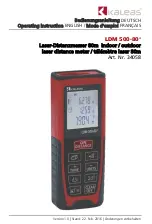
113
19. CHANGING THE SETTINGS
&
Automatic tilt angle compensation mechanism
The vertical and horizontal angles are automatically compensated for small tilt errors using the
2-axis tilt sensor.
• Read the automatically compensated angles when the display has stabilized.
• The horizontal angle error (vertical axis error) fluctuates according to the vertical axis, so when
the instrument is not completely leveled, changing the vertical angle by rotating the telescope
will cause the displayed horizontal angle value to change.
• Compensated horizontal angle = Measured horizontal angle + Tilt in angle/tan (Vertical angle)
• When the telescope is directed close to the zenith or nadir angle, tilt compensation is not
applied to the horizontal angle.
&
Collimation correction
The instrument has a collimation correction function that automatically corrects horizontal angle
errors caused by horizontal axis and leveling axis errors.
&
V mode (vertical angle display method)
&
Sea level correction
The instrument calculates horizontal distance using slope distance values. As this horizontal
distance does not take height above sea level into consideration, performing spherical correction
is recommended when measuring at high altitudes. Spherical distance is calculated as follows.
Where: R = radius of the spheroid (6372.000m)
H
a
= averaged elevation of the instrument point and target point
d
1
= horizontal distance
Zenith
Horiz
Horiz 90°
Spherical distance
R Ha
–
R
------------------ d1
×
=
















































